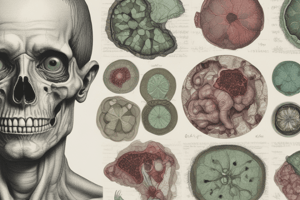Podcast
Questions and Answers
What causes putrefaction in gangrene?
What causes putrefaction in gangrene?
- Inflammation of tissues
- Thrombus or embolus
- Saprophytic bacteria that break down protein (correct)
- Necrosis caused by sudden ischemia
What is gangrene defined as?
What is gangrene defined as?
- Massive tissue necrosis without putrefaction
- Massive tissue necrosis followed by putrefaction (correct)
- Sudden ischemia of tissues
- Inflammation of tissues
What is the difference between dry and moist gangrene?
What is the difference between dry and moist gangrene?
- Dry gangrene occurs in tissues with poor blood supply and moist gangrene occurs in tissues with poor oxygen supply
- Dry gangrene occurs in tissues with poor blood supply and moist gangrene occurs in tissues with good body fluid (correct)
- Dry gangrene occurs in tissues with good blood supply and moist gangrene occurs in tissues with poor blood supply
- Dry gangrene occurs in tissues with good blood supply and moist gangrene occurs in tissues with poor oxygen supply
What happens when gangrene reaches an area with good blood supply?
What happens when gangrene reaches an area with good blood supply?
What is the purpose of the line of demarcation?
What is the purpose of the line of demarcation?
What is the result of the invasion of saprophytic bacteria in necrotic tissue?
What is the result of the invasion of saprophytic bacteria in necrotic tissue?
What is the result of the drainage and evaporation of fluids in dry gangrene?
What is the result of the drainage and evaporation of fluids in dry gangrene?
What is the significance of the groove that forms in the conical stump?
What is the significance of the groove that forms in the conical stump?
What is the characteristic of moist gangrene?
What is the characteristic of moist gangrene?
What is the definition of infective gangrene?
What is the definition of infective gangrene?
When is it likely to see moist gangrene in a limb?
When is it likely to see moist gangrene in a limb?
What is gas gangrene mainly of?
What is gas gangrene mainly of?
What is the effect of Saccharolytic bacteria in gas gangrene?
What is the effect of Saccharolytic bacteria in gas gangrene?
What is the clinical picture of a patient in shock?
What is the clinical picture of a patient in shock?
Flashcards are hidden until you start studying
Study Notes
Circulatory Disturbances: Gangrene
- Definition: Massive tissue necrosis followed by putrefaction
- Causes: Necrosis caused by sudden ischemia or bacterial toxins, putrefaction caused by saprophytic bacteria breaking down protein of necrotic tissue
Types of Gangrene
- Dry gangrene
- Moist gangrene
- Infective gangrene
- Gas gangrene
Dry Gangrene
- Occurs in limbs with arterial occlusion (e.g. thrombus, embolus, surgical ligature)
- Pathological features:
- Massive necrosis occurs distal to site of occlusion
- Dryness of necrotic tissue due to drainage and evaporation of fluids
- Saprophytic bacteria invade necrotic tissue causing putrefaction and bad odour
- Tissue attains black stain due to hydrogen sulfide units with iron of hemoglobin
- Gangrenous process advances slowly along the limb as inflammation causes thrombosis within the vessels
- Toxins of putrefaction irritate adjacent tissue, causing zone of acute inflammation in neighboring healthy part (line of demarcation)
- Granulation tissue grows towards gangrenous part with formation of groove (line of separation)
Line of Demarcation and Separation
- Line of demarcation: Narrow zone of inflammation between healthy and gangrenous tissue
- Line of separation: Groove between healthy and necrotic zone, level of tissue separation
- Line of demarcation is above line of separation
Moist Gangrene
- Causes: Sudden arterial and venous occlusion
- Occurs mainly in internal organs where no evaporation of fluids can occur
- Rapid spread of toxins and rapid putrefaction due to presence of fluids
- Line of demarcation is poor, line of separation is absent, and toxemia is marked
- Seen in crushed limb injuries and diabetic patients due to hyperglycemia and poor body resistance
Infective Gangrene
- Definition: Subtype of moist gangrene where bacteria cause both necrosis and putrefaction
- Example: Cancrum oris caused by treponema Vicenti and bacillus fusiformis
Gas Gangrene
- Definition: Moist gangrene mainly of muscles, occurring in deep wounds contaminated by manured soil containing anaerobic spores
- Caused by saccharolytic bacteria (e.g. Cl. Welchi) or proteolytic bacteria (e.g. Cl. sporogens)
- Tissue destruction causes ischemia that facilitates germination of spores
- Gangrenous tissue stains red or black depending on the type of bacteria
Shock
- Definition: State of tissue hypoperfusion due to inadequate effective circulating blood volume
- Clinical picture:
- Confused patient
- Pale and cold skin
- Rapid weak pulse, low blood pressure, and shallow rapid breathing
Studying That Suits You
Use AI to generate personalized quizzes and flashcards to suit your learning preferences.




